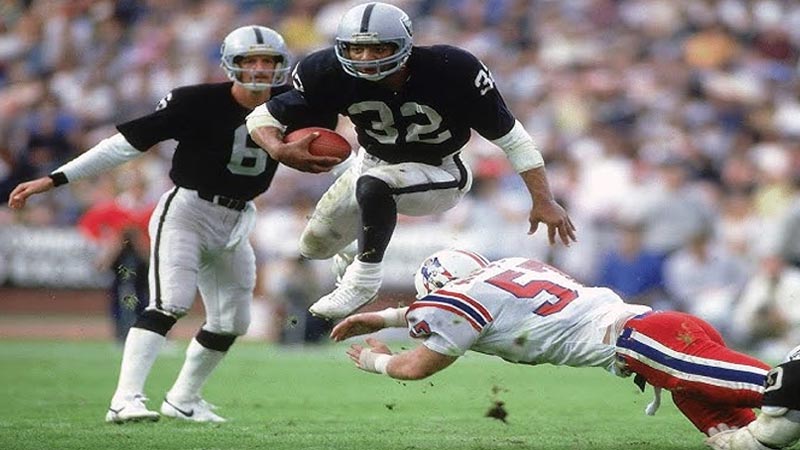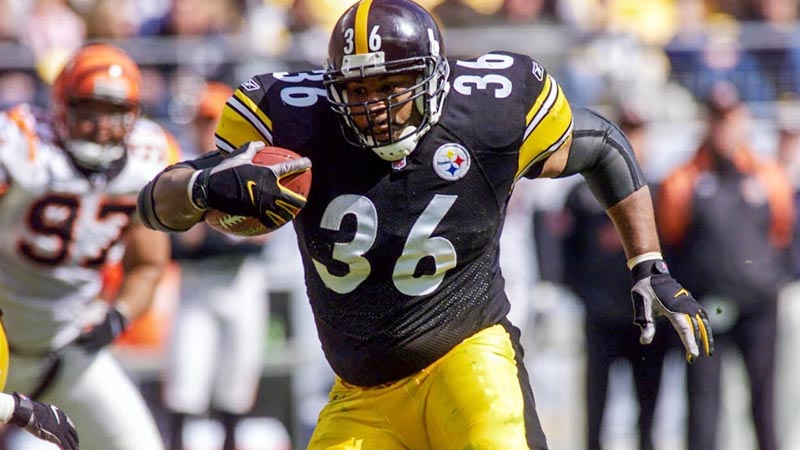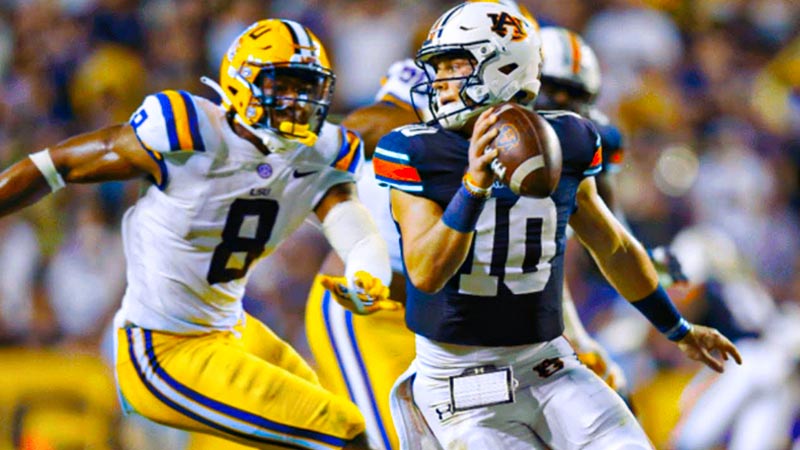In the dynamic world of American football, every position plays a unique role in shaping the game’s strategy. One such pivotal position is that of a tailback, often referred to as a running back.
Operating within the offensive backfield, the tailback is a versatile player responsible for carrying the ball, catching passes, and even aiding in pass protection.
This article delves into the essence of the tailback position, shedding light on their multifaceted contributions and the skills that define their performance on the gridiron. So, stay focused.
What Is Tailback in Football?
In American football, a tailback is a position primarily found in offensive formations like the I-formation or single-back sets. Also referred to as a running back, the tailback is positioned behind the quarterback and is responsible for carrying the ball during rushing plays.
Their main objective is to advance the ball down the field by evading defenders and gaining yardage. Tailbacks are versatile players who must possess a combination of speed, agility, vision, and strength to excel in both rushing and, at times, receiving the ball as a pass-catcher.
They play a pivotal role in a team’s offensive strategy, helping to control the game’s tempo, exploit defensive weaknesses, and maintain a balanced attack.
Role of the Football Tailback
The football tailback, also known as the running back, plays a crucial and multifaceted role in the team’s offensive strategy.
Their responsibilities extend beyond simply carrying the ball. Here are the key roles and functions of a football tailback:
Rushing
The primary duty of the tailback is to carry the football and advance it down the field by evading defenders and gaining yards. They must have excellent vision to identify running lanes, quick acceleration to burst through openings, and the ability to break tackles to gain additional yardage.
Receiving
Many modern offenses involve tailbacks in the passing game. They are often utilized as receivers, catching short passes from the quarterback or even lining up as wide receivers to exploit matchups against linebackers or safeties.
Tailbacks must possess good hands and route-running skills to be effective in the passing game.
Pass Blocking
Tailbacks are also responsible for pass protection, where they block incoming defenders to give the quarterback time to pass the ball. This requires understanding defensive schemes, recognizing blitzes, and effectively picking up blitzing linebackers or defensive backs.
Versatility
A successful tailback must be versatile, capable of adapting to various offensive schemes and play designs. This includes running inside or outside, catching short passes, and occasionally running trick plays to keep the defense off-balance.
Balancing the Offense
Tailbacks contribute to a balanced offensive attack by providing an effective running game. A strong rushing threat can force defenses to commit more resources to stopping the run, opening up passing opportunities for the quarterback and receivers.
Time Management
Running the football effectively can help control the clock and manage the game’s tempo. A skilled tailback can help their team maintain possession of the ball, which is crucial in controlling the flow of the game and limiting the opponent’s opportunities.
Short Yardage and Goal-Line Situations
Tailbacks are often used in short-yardage and goal-line situations, where their ability to gain tough yards is crucial for converting first downs or scoring touchdowns in close proximity to the end zone.
Leadership and Teamwork
Tailbacks must work in tandem with the offensive line and fullback to execute plays successfully. Communication and cohesion with the offensive unit are essential for maximizing the effectiveness of running plays.
Skills of the Tailback Players

Tailback players in football need a diverse skill set to excel in their position. These skills allow them to effectively contribute to the team’s offense and make an impact on the game. Here are the key skills required for tailback players:
Vision and Instincts
A successful tailback has excellent vision to read the defense, identify running lanes, and make quick decisions on which direction to run. Instincts play a crucial role in anticipating defensive movements and reacting accordingly.
Speed and Acceleration
Tailbacks need explosive speed to quickly reach top velocity and break away from pursuing defenders. Acceleration is essential for bursting through gaps in the defensive line and accelerating through the open field.
Agility and Change of Direction
Agility allows tailbacks to make sudden changes in direction, juke defenders, and elude tacklers. The ability to change direction quickly is crucial for navigating through traffic and avoiding tackles.
Balance and Body Control
Maintaining balance while running through traffic or being tackled is crucial for gaining extra yardage after initial contact. A tailback’s body control enables them to stay on their feet and maintain forward momentum.
Strength and Power
Tailbacks need a degree of physical strength and power to break tackles, push through defenders, and gain yards after contact. This strength is especially important in short-yardage and goal-line situations.
Catching Ability
As versatile players, tailbacks must be proficient at catching passes. This includes catching short dump-off passes, screens, and even more challenging receptions downfield.
Pass Blocking
Tailbacks are expected to pass block effectively to protect the quarterback. This involves reading defensive blitzes, picking up blitzing defenders, and providing the quarterback with a clean pocket.
Field Awareness
Tailbacks should have a good understanding of the field’s layout, including the position of defenders, teammates, and boundaries. This awareness helps them make split-second decisions while running the ball.
Patience and Timing
Patience is essential for allowing blocks to develop and finding the right moment to accelerate through gaps. Tailbacks need a keen sense of timing to exploit openings created by the offensive line.
Football IQ
Offensive schemes, defensive formations, and the overall game situation are crucial. This knowledge helps tailbacks make informed decisions on the field and adapt to changing circumstances.
Leadership and Communication
Tailbacks often communicate with the offensive line and other teammates to ensure everyone is on the same page regarding play execution, blocking assignments, and adjustments.
Endurance and Conditioning
Tailbacks must maintain their energy and performance throughout the game. Good endurance and conditioning allow them to be effective in both the early and late stages of a match.
Difference Between a Tailback and Running Back

In American football, the terms “tailback” and “running back” are often used interchangeably, but there can be a slight distinction in their usage based on the offensive formation and historical context. Here’s a breakdown of the difference between the two terms:
Running Back
The term “running back” is a broad and more modern description that encompasses various types of running backs in the offensive lineup. It refers to any player whose primary responsibility is to carry the ball and gain yards on rushing plays.
Running backs can line up in different positions, including behind the quarterback, beside the quarterback, or even as a slot receiver.
Tailback
“Tailback” is a more specific term that has its origins in older offensive formations like the single-wing and T-formation. In these formations, the tailback was positioned at the “tail” end of the offensive backfield, behind the fullback and quarterback.
The tailback was the primary ball carrier and often had more distance between them and the line of scrimmage, giving them a running start before receiving the ball. As offensive formations evolved, the term “tailback” became synonymous with the broader term “running back.”
So, the primary difference between a “tailback” and a “running back” lies in historical context and the specific offensive formations in which they were used.
Difference Between Tailback And Fullback
In American football, both tailbacks and fullbacks are positions in the offensive backfield, but they serve different roles and have distinct responsibilities within the team’s offensive strategy. Here’s a comparison of the differences between tailbacks and fullbacks:
Tailback
- Primary Ball Carrier: The tailback, also known as the running back, is typically the primary ball carrier in the offense. They receive handoffs from the quarterback and are responsible for advancing the ball by running through openings in the defense.
- Speed and Agility: Tailbacks are often known for their speed, agility, and elusiveness. They rely on quick cuts, changes of direction, and acceleration to evade defenders and gain yardage.
- Receiving: Many tailbacks have strong receiving skills and are used as pass-catching options out of the backfield. They can catch short passes, and screens, and even line up as wide receivers in certain formations.
- Versatility: Tailbacks are versatile players who can impact the game both as runners and receivers. They need a combination of skills, including vision, speed, agility, and catching ability.
Fullback
- Lead Blocker: The fullback is often considered a lead blocker in the offense. They primarily block for the tailback or other runners, creating lanes and eliminating defenders to help the ball carrier advance.
- Short-Yardage and Goal-Line Situations: Fullbacks are commonly used in short-yardage and goal-line situations where power running is required to gain crucial yardage. They have the strength to push through defensive lines and gain tough yards.
- Blocking: Fullbacks are known for their blocking abilities, whether it’s lead blocking for the tailback, picking up blitzing defenders in pass protection, or blocking for other offensive players.
- Less Emphasis on Speed: While fullbacks can have good athleticism, speed, and agility are generally less emphasized compared to tailbacks. Their physicality and ability to engage with defenders are more important.
The key difference between a tailback and a fullback lies in their primary responsibilities on the field. Tailbacks are the main ball carriers who rely on speed, agility, and versatility to make plays both as runners and receivers.
Fullbacks, on the other hand, primarily focus on blocking, lead blocking for other runners and contributing in short-yardage situations.
FAQs
What is the primary role of a tailback?
The primary role of a tailback is to carry the ball during rushing plays and advance it down the field by evading defenders and gaining yardage.
What other responsibilities do tailbacks have?
Tailbacks are often involved in the passing game as receivers, catching short passes from the quarterback and even lining up as wide receivers in certain formations.
How important is the vision for a tailback?
Vision is crucial for tailbacks as it allows them to read the defense, identify running lanes, and make quick decisions about where to run.
What skills do tailbacks need?
Tailbacks require a combination of speed, agility, strength, catching ability, and football IQ to excel as versatile offensive weapons.
How do tailbacks contribute to a team’s strategy?
Tailbacks help in maintaining a balanced offensive attack, controlling the game’s tempo, and exploiting defensive weaknesses, thereby influencing the overall flow of the game.
Wrapping Up
In the complex tapestry of American football, the tailback stands as a multifaceted player, embodying the essence of adaptability and versatility.
Their ability to run, catch, block, and think strategically makes them a vital asset to any team’s offensive arsenal.
As the game evolves, the role of the tailback continues to evolve, showcasing the enduring importance of their presence on the field. Thank you for your support.







